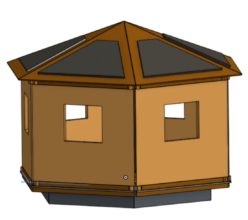The vision of the Reconstructable House is to offer a sustainable stable house that offers its residents a healthy living with a minimal ecological footprint for an affordable price.
As the construction can be completely disassembled and does produce nor leave any waste it can be installed in remote and sensitive areas and be an alternative to urban growth.
Sustainability
The main goal of the reconstructable house is to offer a sustainable and healthy way of housing.
The biggest ecological win is the replacement of concrete and cement by natural and recycled material. If you are not aware of the ecological disaster of concrete, please read the article “the concrete problem” and the continuous progression to make those materials stronger and more effective
- The fragmentation of the construction into small elements will allow compact transport with small vehicles (compared to huge trucks for conventional building).
- The construction is designed to allow easy assembly and disassembly by hand. This will create work and reduce the energy needed to build up the house
A future aspect will be the contribution of the residents to contribute to sustainability by replanting a multiple of the trees that were needed to build the house. This will improve the ecological balance and it will provide work and new material for reconstructing other houses.
The fundamentation will be done with Ground screws that can be installed and extracted leaving nothing but a small hole in the ground. This means the soil and its fertility will remain untouched. This is a great feature compared to conventional building that are destroying the micro climat in the soil forever.
Quality of life
The essence of the Reconstructable House is to provide a high-grade living space. The the house must be solid. It must built with natural materials wherever possible and allow a decent housing to its residents. The interior will be light and provide a healthy indoor climate. Another unique feature is to allow sustainable housing with minimal impact to the surrounding.
Stability
An unconditional must for a house construction is stability. The Reconstructable House has a unique advantage in this aspect: Since it can be assembled and disassembled in a short time, it is possible to execute the strength test in reality. After disassembly the parts can be thoroughly examined and analysed for critical point. This method allows to eventually prove the stability instead of relying on theoretical calculation.
As the reconstructable house can be disassembled easily, it is possible to judge its quality over time. The tests with models already show a very high stability and now we are on the way to test the house in full scale. The persistency against wind and storm is already proven but our ambition is to get a persistance against earth quakes that is at least as good as of a concrete house. Therefore the current research is focussing on the question how to optimise the elasticity of the walls so it carries the static load with sufficient certitude and absorbe shock waves with minimal impact on the bearing capacity.
Managed life cycle
Todays buildings are constructed to build to last 50 to 100 years. Very often the buildings are demolished after 20 years because they don’t correspond to the modern demand and style of the new residents. This causes a lot of energy for the building and the demolition.
By using natural material, mostly wood that is not chemically treated, an instance of the reconstructable will have a limited number of years. We don’t consider this as a deficiency, but a quality. If at the end of the life cycle of a house a resident wants to stay in the place, a new house will be build at the same place and the old house will be disassembled and reused if possible.
The benefits of this system are:
- simple material like wood that is not chemically treated can be used
- The construction can constantly be checked and improved over time
- Costs reduction because it does not need the expensive investment for a long durability
- As the house does not has to stay forever, it will be also possible to rent the place for the time needed instead of buying it.
Simplicity
Another major goal is the simplicity of the construction. The more complicated the construction is, the more difficult will be the assembly and eventually the more expensive it will be.
If it is easy and fast, it will also allow to rebuild the house whenever needed for security or if the demand is changing.
Last but not least a simple construction is easy to control and gives more people a chance to contribute.
Simplicity has also a economical aspect. If the construction is focusing on the basic needs for housing, fancy and luxurious features will be avoided and it will cost less.
Affordability
An important goal of the construction is to be economical. The solution will only be successful if it provides a decent housing for a reasonable price.
The principles of simplicity contribute to this, as it is cheaper to assemble a simple then a sophisticated construction. Also the usage of non-treated naturally growing and biodegradable materials contribute to this.
Another important aspect is the principle of terminability. As the house can be disassembled without leaving any environmental damage, it is possible to build it anywhere and also for a limited time only. This allows to rent the ground for limited time which not only reduces the costs for housing.
